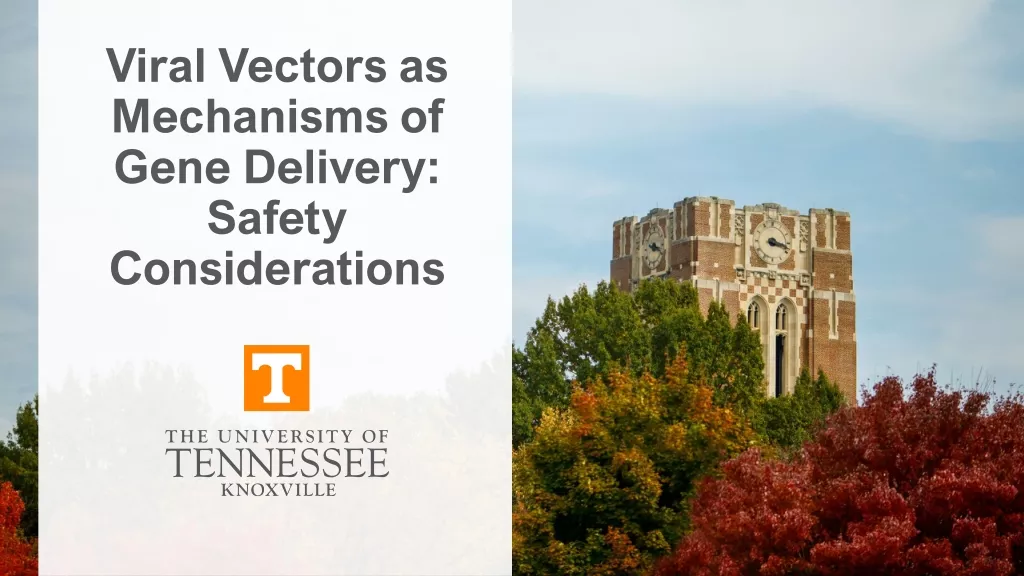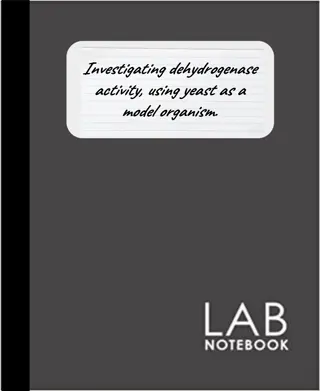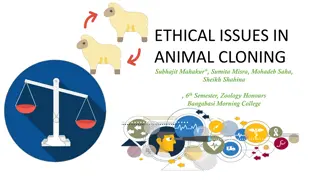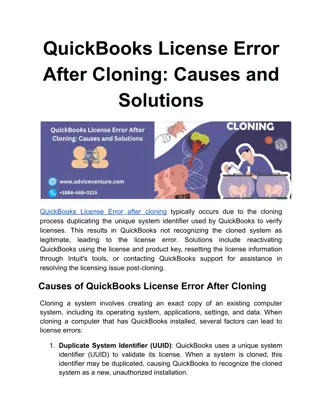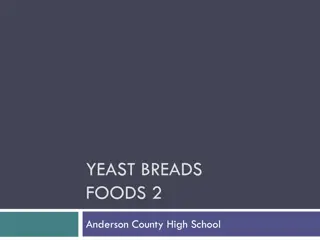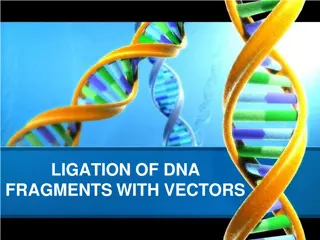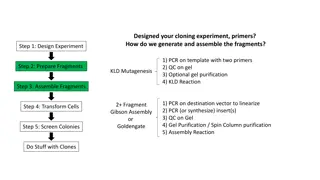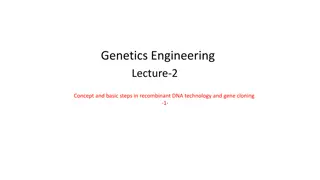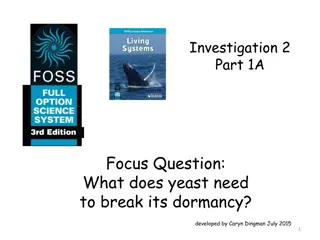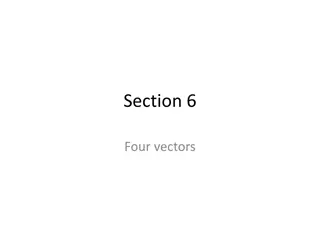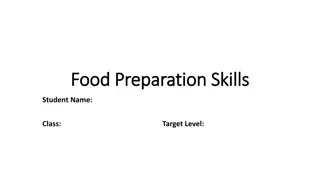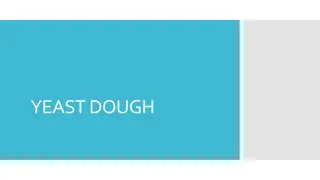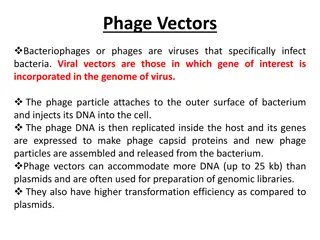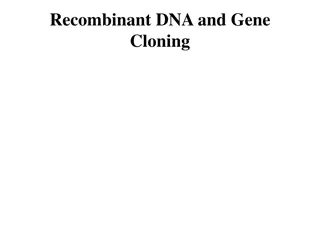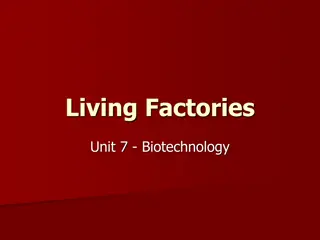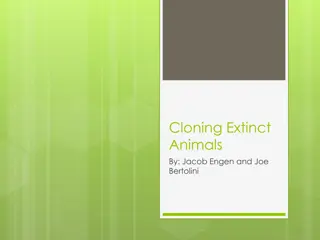Cloning in Yeasts: Vectors and Selectable Markers
Yeasts like Saccharomyces cerevisiae and Schizosaccharomyces pombe are valuable organisms for eukaryotic gene expression. They offer easy growth like bacteria and are genetically well-characterized. Yeast selectable markers and vectors enable efficient cloning and expression of genes. The use of shuttle vectors and different types of yeast plasmid vectors facilitate gene manipulation in both E. coli and yeast. Understanding the various cloning techniques in yeasts can lead to important advancements in biotechnology.
Download Presentation

Please find below an Image/Link to download the presentation.
The content on the website is provided AS IS for your information and personal use only. It may not be sold, licensed, or shared on other websites without obtaining consent from the author.If you encounter any issues during the download, it is possible that the publisher has removed the file from their server.
You are allowed to download the files provided on this website for personal or commercial use, subject to the condition that they are used lawfully. All files are the property of their respective owners.
The content on the website is provided AS IS for your information and personal use only. It may not be sold, licensed, or shared on other websites without obtaining consent from the author.
E N D
Presentation Transcript
Cloning in Yeasts 1. Preferred organisms for functional expression of eukaryotic genes. 2. Single celled, and easy to grow like bacteria 3. Yeast strains are genetically well characterized. Detailed genetic maps are available for Saccharomycescerevisiae and Schizosaccharomyces pombe 4. Powerful transformation techniques are available Budding Yeast (S. cerevisiae) Fission Yeast (S. Pombe) Many yeast genes are expressed in E. coli. This allows the isolation of a number of Yeast genes for metabolically important genes by their ability to complement cognate genetic defects in E. coli mutants.
Yeast Selectable Marker The most commonly used yeast selectable markers are genes which complement a specific auxotrophy (Leu-, His-, Trp-, etc.). The most commonly used auxotrophic selection markers for the selection of Transformants are LEU2, TRP1, URA3 and HIS3 used in corresponding mutant strains, Which are auxotrophic for leucine, tryptophan, uracil and histidine, respectively. Complementation Cloning Yesat gene HIS3 complement hisB (E. coli) Yesat gene TRP5 complement trpAB (E. coli) Yesat gene LEU2 complement leuB (E. coli) Yesat gene URA3 complement pyrF (E. coli) Yesat gene ARG4 complement argH(E. coli)
Yeast on Plate A shuttle vector is a vector (usually a plasmid) constructed so that it can propagate in two different host species.Therefore, DNA inserted into a shuttle vector can be tested or manipulated in two different cell types. The main advantage of these vectors is they can be manipulated in E. coli, then used in a system which is more difficult or slower to use (e.g. yeast).
Vectors for cloning in yeast The discovery of a 2 m plasmid in most strains of Saccharomyces cerevisiae led to the development of cloning vectors in yeast. The 2 m plasmid is 6.318 kb in size. It is present in 70-200 copies per cell. A number of shuttle vectors based on 2 m plasmid and bacterial plasmids have been constructed which can replicate either in E.coli or yeast. Yeast plasmid vectors are of four types, yeast episomal plasmids (YEps), yeast integrative plasmids (YIps) yeast replicative plasmids (YRps) and yeast centromeric plasmids (YCps). In addition to plasmid vectors, yeast artificial chromosomes (YACs) are also used as vectors for cloning large pieces of DNA.
i) Yeast episomal plasmids (YEps) These are derived from 2 m plasmid. Some YEps contain the entire 2 m plasmid; others include just the 2 m origin of replication. An example of latter type is YEp13. It is a shuttle vector and can be replicated both in E. coli and yeast. It contains 2 m origin of replication, yeast gene leu2 as selectable marker and entire sequence of pBR322.The leu2 gene codes for an enzyme involved in biosynthesis of amino acid leucine. YEps may replicate autonomously or integrate in one of the yeast chromosomes by homologous recombination. They have high transformation frequency of 10,000 to 100,000 transformants/ g DNA.
ii) Yeast integrative plasmids (YIps) These are basically bacterial plasmids carrying a yeast gene. YIp5 is an example of yeast integrative plasmid. It has ura3 gene inserted in pBR322. The gene ura3 codes for an enzyme involved in biosynthesis of pyrimidine nucleotides and acts as selectable marker. The plasmid cannot replicate autonomously as it lacks 2 m origin of replication and survives by integrating in yeast chromosomal DNA. They have very low transformation frequency, less than 100 transformants/ g DNA.
iii) Yeast replicative plasmids (YRps) They carry a part of chromosomal DNA with an origin of replication (ARS: Autonomously replicating sequence and one or two selectable markers and are capable of independent replication. They have transformation frequency between 1000 and 10,000 transformants/ g DNA.
iv) Yeast centromeric plasmids (YCps) These are shuttle vectors that behave as small chromosomes and replicate only once during each cell divison. They contain i) origin of replication called ARS sequence , ii) CEN sequence (for proper segregation of chromosomes) and iii) a selectable marker such as leu2 from yeast and sequences from bacterial plasmid having ori region and selectable marker (Apr). They are stably maintained at one copy per cell.
v) Yeast Artificial Chromosomes (YACs) YACs are artificial chromosomes that replicate in yeast cells. Main features of these vectors are: 1. Autonomously replicating sequence (ARS) necessary for the replication in yeast cells. 2. Telomeres (TEL), which are ends of chromosomes involved in the replication and stability of chromosomes. 3. A yeast centromere (CEN), required for proper segregation of chromosomes 4. Selectable markers that allow the easy isolation of yeast cells that have taken up the artificial chromosome. 5. Unique RE sites. YACs are capable of carrying a large DNA fragment (up to 3000 kb), but their transformation efficiency is very low.
Working with a YAC (A) The cloning vector pYAC3. (B) To clone with pYAC3, the circular vector is digested with BamHI and SnaBI. BamHI restriction removes the stuffer fragment held between the two telomeres in the circular molecule. SnaBI cuts within the SUP4 gene and provides the site into which new DNA will be inserted. Ligation of the two vector arms with new DNA produces the structure shown at the bottom. This structure carries functional copies of the TRP1 and URA3 selectable markers. The host strain has inactivated copies of these genes, which means that it requires tryptophan and uracil as nutrients. After transformation, cells are plated onto a minimal medium, lacking tryptophan and uracil. Only cells that contain the vector, and so can synthesize tryptophan and uracil, are able to survive on this medium and produce colonies. Note that if a vector comprises two right arms, or two left arms, then it will not give rise to colonies because the transformed cells will still require one of the nutrients. The presence of insert DNA in the cloned vector molecules is checked by testing for inactivation of SUP4. This is done by a color test: on the appropriate medium, colonies containing recombinant vectors (i.e. with an insert) are RED; non-recombinants (vector but no insert) are WHITE. Transformant colonies containing the exogenous DNA insert within the SUP4 gene are detected by their red colour, due to the inactivation of the suppressor activity and the consequent accumulation of a red metabolic precursor.
Cloning vectors and their insert capacities Vector system Host cell Insert capacity (kb) Plasmid E. coli 0.1-10 Bacteriophage E. coli 5-25 Cosmid E. coli 35-45 Bacteriophage P1 E. coli 80-100 BAC (bacterial artificial chromosome) E. coli 50-300 P1 bacteriophage- derived AC (PAC) E. coli 100-300 YAC Yeast 200-500 Human AC Cultured human cells >2,000


